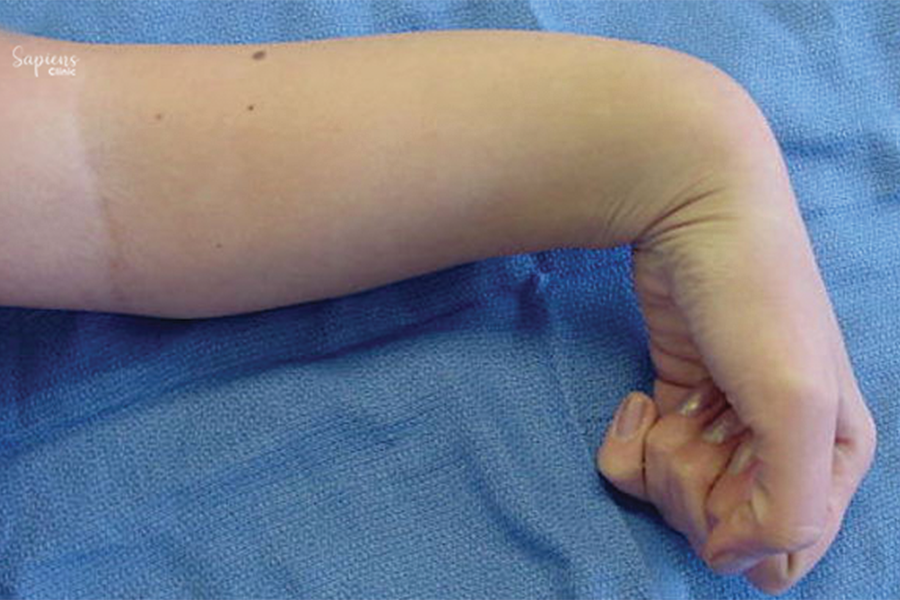Spasticity and Upper Limb Deformities Treatment in Malleshwaram
daily activities, affecting quality of life. At Sapiens Clinic in Malleshwaram, we specialize in diagnosing and treating these conditions, aiming to restore function, reduce discomfort, and enhance overall well-being.
Understanding Spasticity and Upper Limb Deformities
Spasticity refers to involuntary muscle stiffness or tightness, often resulting from neurological conditions such as stroke, cerebral palsy, or spinal cord injuries. This increased muscle tone can lead to deformities in the upper limbs, including abnormal postures, joint contractures, and impaired movement patterns.
Causes and Risk Factors
Spasticity and resultant deformities can arise from various factors :
- Neurological Conditions: Such as stroke, traumatic brain injury, cerebral palsy, and multiple sclerosis.
- Spinal Cord Injuries: Leading to disrupted nerve signals and muscle control.
- Brain Injuries: Affecting motor control centers.
- Neurodegenerative Diseases: Progressive conditions impacting nerve function.
Early identification and management are crucial to prevent long-term complications.
Symptoms
Common signs indicating spasticity and upper limb deformities include :
- Muscle Stiffness: Persistent tightness in the arms or hands.
- Involuntary Muscle Spasms: Sudden, uncontrolled movements.
- Abnormal Postures: Such as flexed elbows or wrists.
- Joint Contractures: Permanent tightening of muscles or tendons.
- Difficulty with Fine Motor Skills: Challenges in tasks like writing or buttoning clothes.
Prompt medical evaluation is essential for optimal recovery.
Diagnosis
Accurate diagnosis involves:
- Clinical Evaluation: Assessing muscle tone, reflexes, and movement patterns.
- Imaging Studies: MRI or CT scans to identify underlying neurological issues.
- Electrodiagnostic Tests: EMG and nerve conduction studies to evaluate nerve and muscle function.
These assessments help determine the extent and location of the impairment.
Treatment Options
Management strategies are tailored based on the specific condition:
- Conservative Therapies :
- Physical Therapy: Exercises to improve flexibility and strength.
- Occupational Therapy: Training to perform daily activities safely.
- Medications: Muscle relaxants or antispastic agents.
- Splinting and Bracing: To maintain joint position and prevent contractures.
- Interventional Treatments:
- Botulinum Toxin Injections: To reduce muscle overactivity.
- Intrathecal Baclofen Therapy: Delivery of medication directly to the spinal fluid.
- Surgical Interventions:
- Tendon Release or Transfer: To correct deformities and improve function.
- Joint Stabilization Procedures: To maintain proper alignment.
- Selective Dorsal Rhizotomy: Cutting nerve fibers to reduce spasticity.
Early intervention often leads to better outcomes.
Recovery and Rehabilitation
Post-treatment rehabilitation focuses on :
- Restoring Function: Through targeted exercises and therapies.
- Pain Management: Utilizing medications and therapeutic modalities.
- Monitoring Progress: Regular follow-ups to assess recovery and adjust treatment plans.
Recovery timelines vary based on the severity of the condition and the treatment approach.
Conclusion
Spasticity and upper limb deformities can significantly impact daily activities and overall well-being. At Sapiens Clinic, Malleshwaram, our multidisciplinary team is dedicated to providing comprehensive care, from accurate diagnosis to personalized treatment plans, ensuring optimal recovery and prevention of future complications.
FAQs
1. What causes spasticity in the upper limbs?
Spasticity often results from neurological conditions like stroke, cerebral palsy, or spinal cord injuries that disrupt normal muscle control.
2. Can spasticity be cured?
While spasticity may not be entirely curable, various treatments can effectively manage symptoms and improve function.
3. How does botulinum toxin help in treating spasticity?
Botulinum toxin injections relax overactive muscles, reducing stiffness and improving movement.
4. Is surgery always necessary for upper limb deformities?
Not always. Surgery is considered when conservative treatments are ineffective or when deformities significantly impair function.
5. How long does rehabilitation take after treatment?
Rehabilitation duration varies depending on the individual’s condition and response to therapy, ranging from weeks to months.

Leave a Reply